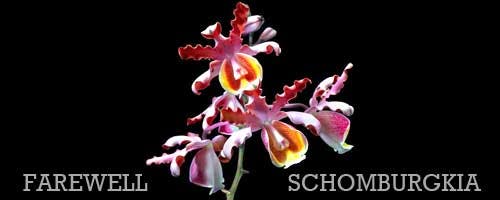
Certain tropical orchids are well-suited and often used as landscape subjects in frost-free areas of Florida. Schomburgkia tibicinis (above) was one of them. I say "was", because although the orchid is still around, the name isn't. I will use it in this personal tribute until farther down the page when we deal with new order of taxonomy.
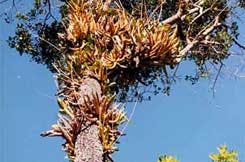
The yellow pseudobulbs of Schomburgkia (Myrmecophila) tibicinis encircling the top of a tree in Belize.
I came to West Palm Beach forty years ago. I was growing a few orchids then and remember seeing a fairly robust specimen of Schomburgkia tibicinis growing high on a Royal Palm tree at Hennegan's Garden Center on State Road 80. In those days I had thought most orchids were of a delicate nature and wondered about this orchid with a long inflorescence that was growing in nearly full sun. Years later, I would see this species growing in a similar, but even brighter, setting in its habitat in Belize. By that time, I was a far smarter orchidist and knew about the schomburgkias' preference for bright light. My early exposure to this dramatic orchid gave me an introduction to the diversity of orchids and Schomburgkia tibicinis has always been a favorite. I learned about the orchid's association with ants that its current name reflects. Although we never saw ants taking up residence in hollowed-out backbulbs, it seemed that ants always showed up on the inflorescences of flowering plants. I wondered if there were some quality to the sugary nectar on the flowers and pedicels that had a special attraction for ants, preparing the relationship for future housing. As with that other species found in Belize, Coryanthes macrantha, the orchid provides the shelter and the ants provide the defense. I also learned the folklore; the dried-out pseudobulbs are used as toy horns by native children, giving the orchid the common name, "cow horn orchid". I have always been drawn to orchids that have a history as well as a pretty face and Schomburgkia tibicinis fills the bill nicely. I picked up my first Schomburgkia tibicinis from a long-gone local business called Quiet Place Nursery. They were a small orchid firm behind a busy intersection in Lake Worth. There was nothing but white sand underneath the benches and one thin layer of shadecloth above the plants. Those orchids that weren't mounted were potted in cypress mulch topped with Osmacote. As the owner Marie explained, "Maybe these plants are grown a little tough, but we don't have to worry about people taking them home and killing dainty little things. If they'll grow here, they'll grow anywhere."
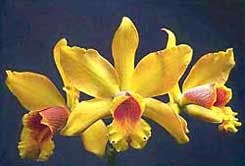
Recchara Adele King 'Barbaree' AM/AOS
There are many other fine ant-associated schomburgkias to know and grow. The Kew Monocot Checklist shows ten species, four varieties and one natural hybrid. Some of these can be found in the trade and are popular among hobbyists, especially those living in mild climates. Schom. thomsoniana and Schom. humboldtii are popular on their own with the former being a parent for a number of successful intergeneric hybrids; Recchara Adele King (x Blc. Waikiki Gold) and Schombocattleya Trudy Fennell (x C. guttata) being awarded examples. At opposite ends of inflorescence length; Schom. brysiana is best used as a garden subject unless you have a high greenhouse roof, while Schom. wendlandii with its unique non-resupinate flowers and comparatively short inflorescence is most suitable for greenhouse growing.
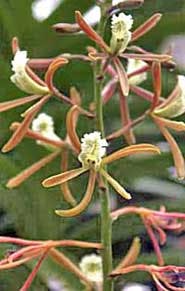
Schom. wendlandii has a relatively short inflorescence suitable for the small greenhouse.
The genus Schomburgkia was established by Lindley in 1838 with the type species being Schom. crispa. That species has not much in common with the ant orchids yet up until recently, was still a Schomburgkia. The name honors Moritz Richard Schomburgk, a German-born gardener and plant collector who went on to become the director of the Adelaide Botanic Garden in 1865. Despite Richard being the honoree, it was his older brother Robert Hermann Schomburgk who dragged his little brother along on his second British-sponsored boundary-mapping expedition to British Guiana (1840-1844). There was also a middle Schomburgk brother named Otto who emigrated to Australia with Richard in 1849. Although Veitch reported that Robert discovered the type for the genus, this is reflected nowhere in today's nomenclature. As a matter of fact, of the eight species in the Kew Monocot Checklist bearing the Schomburgk name, all are attributed to Robert Hermann and only one was an orchid. That single orchid species is Sobralia elisabethiae R.H.Schomb. Schomburgkia humboldtii, described by Reichenbach in 1856, acknowledged the Schomburgk brothers long-standing friendship with the great naturalist and explorer, Alexander von Humboldt. As a note of trivia, it was Richard Schomburgk who discovered that Victorian rage, the giant waterlily, Victoria amazonica, described as Victoria regia by Lindley in 1837.
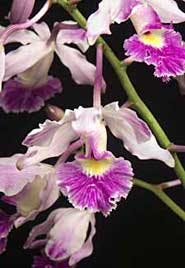
Schomburgkia humboldtii 'Ruben' CHM/AOS
We have never grown what were, until recently, considered the "true" schomburgkias; those from South America. Some grow them successfully here in South Florida but I suspect many of them are from elevations higher than the ten-foot average across most of the southern part of the peninsula. Our summer night temperatures never go below 75° F. This group would include the type for the genus, Schom. crispa (now Laelia marginata (Lindl.) L.O.Williams) and many fine orchids such as Schom. undulata, Schom. rosea and others. For years there has been confusion, differing opinions and rumblings about changes in Schomburgkia and Laelia so we can't say we weren't forewarned. Withner, in his 1992 Volume III of The Cattleyas and Their Relatives had not yet reached the conclusions that today's taxonomists have. He kept a slightly enlarged concept of Schomburgkia that included the South American species, the ant-associated species, and one Mexican (Guatemala, Honduras too) Laelia: L. superbiens. This is not so odd because the Mexican species has been passed around genera like a hot tamale, having visited Cattleya, Laelia, Schomburgkia and even Bletia. Withner was sharp enough to deduce that the Mexican Laelia anceps was different enough from the Colombian Schomburgkia splendida to not put them in the same genus. But today's taxonomists, who are heavily vested in DNA evidence as the irrefutable truth, have indeed lumped the South American schomburgkias into the same genus as the Mexican laelias - Laelia. Although I am happy to see such a pretty name preserved (Laelia, named after one of the Vestal Virgins), I expect that some time in the future we may see this genus spilt because of floral and vegetative characteristics of certain species.
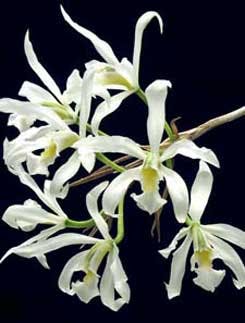
Laelia superbiens var. alba
So the genus Schomburgkia is gone. The South America species have moved north to Laelia and the ant-lovers are now in the genus Myrmecophila. Withner addressed the latter move even though he himself used Schomburgkia for all of them in vol. III: "The choice of using the segregate genus (Myrmecophila) for the ant-inhabited taxa, or keeping them altogether within Schomburgkia, seems to me a relatively arbitrary one". He goes on to propose keeping them all in Schomburgkia and dealing with the differences at the sub-generic level. Now there's a thought that appeals to me. I always liked Pabst & Dung's revision of Brazilian laelias (Orchidaceae Brasiliensis, vol.I, 1975). They presented a group of orchids that had some things in common (Laelia), yet some differences (Cattleyodes, Hadrolaelia, Parviflora, Microlaelia) - sections within the genus.
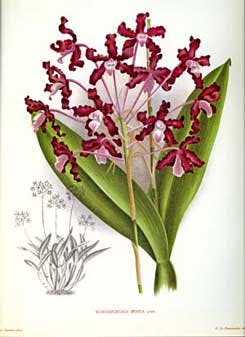
Schomburgkia rosea Linden ex Lindl. as pictured in Lindenia (above left). Today it is known as Laelia rosea (Linden ex Lindl.) C.Schweinf. -- "It is difficult to point out the differences between these species (Schom. rosea, undulata, splendida, crispa, schultzei), for they reside in details of the lip and in the general aspect or the plant and inflorescence". Pedro Ortiz, Native Colombian Orchids, vol. 4.
I suppose I will get used to it, but only if name changes stop coming so rapidly. I for one will be happy to say goodbye to those silly hybrid genus names from the everything-in-Sophronitis days, like Thwaitseara. But I will miss hearing the rich guttural sound of Schomburgkia (or as one friend pronounced it, Schromburgkia). The name itself holds a special magic for me; remembrances of my early days as an orchid grower when every new orchid discovered was a source of excitement. I'll miss hearing the call of the Schombocat as I console myself watching ants crawl up and down the four-foot infloresence of a Myrmecophila tibicinis next spring.
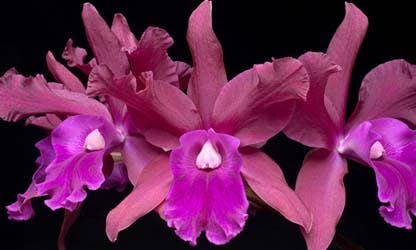
The promising, eye-catching hybrid, Rhyncatlaelia Graf's Fusion 'Delicia Purpura'HCC/AOS (Rlc. Edisto x L. undulata)
Greg Allikas - September 2009
References:
Withner, Carl. 1992. The Cattleyas and their Relatives, Volume III. Timber Press. Portland
Menezes, L.C 1995. Laelia purpurata. Expressao E. Cultura. Rio de Janeiro.
Linden, J., Linden, Lucien, Rodigas, E.M., Rolfe, R.A 1993. Lindenia. Naturalia. Turriers.
Escobar, Rodrigo. 1992. Native Colombian Orchids, Volume 4. Compañía Litográfica Nacional S.A.. Medellin
NOTE: It has been brought to my attention that the flower pictured at the top of this page is actually Myrmecophila grandiflora (Lindl.) Carnevali & J.L.Tapia & I.Ramírez. These plants have been sold and grown in Florida for years as Schomburgkia tibicinis. Many thanks to Paul Storm for this observation.








